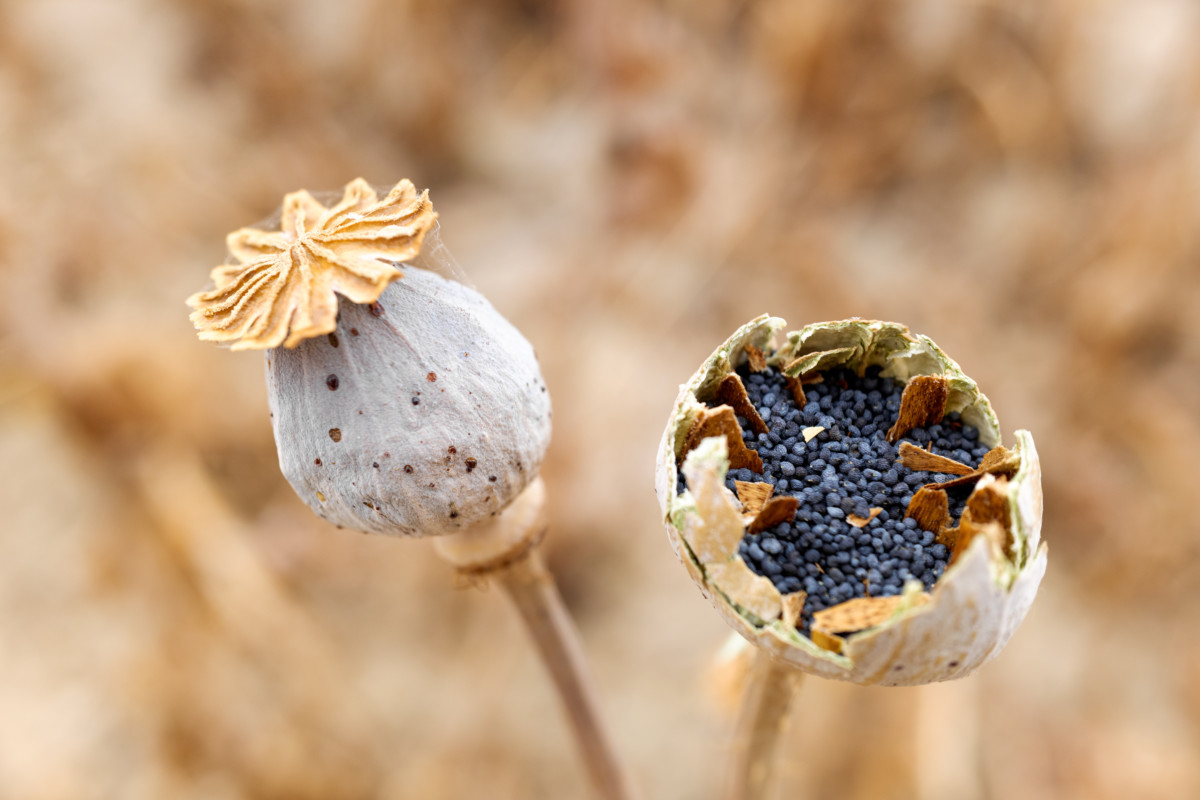
Welcome to the fascinating world of breadseed poppy, a delicate and enigmatic flowering plant that has captivated gardeners and plant enthusiasts for centuries. Also known as Papaver somniferum, breadseed poppy is not only renowned for its brilliant beauty but also for its interesting historical and cultural significance.
In this article, we will delve into 19 intriguing facts about breadseed poppy that will both educate and amaze you. From its origins and cultivation methods to its medicinal properties and culinary uses, there is so much to discover about this enchanting plant. So, let’s embark on a journey and uncover the secrets behind the breadseed poppy’s allure and mystique.
Key Takeaways:
- Breadseed poppy, also known as Papaver somniferum, has a rich history dating back to ancient civilizations. It holds cultural symbolism, provides culinary seeds and oil, and attracts pollinators, making it a versatile and captivating plant.
- The breadseed poppy plant is not only a beautiful addition to gardens but also has diverse uses. From its medicinal properties to its role in culinary applications and as a symbol of remembrance, this enigmatic plant continues to intrigue and inspire.
The Origins of Breadseed Poppy
Breadseed poppy, scientifically known as Papaver somniferum, is believed to have originated in the Mediterranean region thousands of years ago. This captivating plant has a long and mysterious history, with evidence of its cultivation dating back to ancient civilizations.
The Symbolism of Breadseed Poppy
Breadseed poppy holds significant cultural and symbolic meanings. In many cultures, it is associated with fertility, death, sleep, and resurrection. Its delicate and vibrant flowers have inspired artists, poets, and storytellers throughout the ages.
Breadseed Poppy Uses in Folk Medicine
The seeds of the breadseed poppy have been used in traditional medicine for various purposes. They contain alkaloids, such as codeine and morphine, which have been utilized for their pain-relieving and sedative properties. However, it is essential to note that the medicinal use of these seeds should only be done under proper supervision.
The Intriguing Opium Connection
Breadseed poppy is the source of opium, a powerful substance derived from its latex. Opium has a long history of use for its pain-relieving and euphoric effects. However, due to its potential for misuse, opium and its derivatives are strictly regulated in most countries.
An Annual Blossom
Breadseed poppy is an annual flowering plant, which means it completes its life cycle within a year. This beautiful plant produces stunning flowers in different shades of red, pink, purple, and white. The flowers last only a few days, but they leave behind captivating seed pods.
Versatile Culinary Seed
The seeds of the breadseed poppy are commonly used in culinary applications. They add a mild nutty flavor and provide delightful crunch to bread, pastries, salads, and even pasta dishes. The seeds are often sprinkled on top of baked goods for added texture and visual appeal.
A Sanctuary for Pollinators
Breadseed poppy attracts various pollinators, including bees, butterflies, and birds. The nectar and pollen of its flowers provide a valuable food source for these essential creatures. By including breadseed poppy in your garden, you can contribute to the well-being of pollinators and the overall biodiversity of your area.
Withstanding Diverse Climates
Breadseed poppy is a hardy plant that can thrive in different climate conditions. It can adapt well to temperate, subtropical, and even cold regions. This resilience makes it a popular choice for gardeners who want to add a touch of beauty to their landscapes.
The Alluring Seed Pods
One of the most unique features of breadseed poppy is its fascinating seed pods. These oval-shaped pods develop after the flowers fade away and contain numerous small seeds. As the seed pods dry, they create mesmerizing rattling sounds when shaken, adding a whimsical aspect to the plant.
An Ancient Cultivation Tradition
The cultivation of breadseed poppy dates back centuries. It has been grown for its seeds, oil, and opium since ancient times. This plant has been highly valued by civilizations such as the Ancient Egyptians, Greeks, Romans, and Persians, who recognized its diverse uses and cultural significance.
Psychoactive Properties
Breadseed poppy seeds contain minute amounts of psychoactive alkaloids, which can cause a mild euphoric effect when consumed in large quantities. However, it is important to note that the levels of these alkaloids in commercially available seeds are extremely low and have minimal psychoactive impact.
A Source of Culinary Oil
Breadseed poppy seeds are not only used as a culinary ingredient but also as a source of oil extraction. The oil extracted from these seeds is rich in essential fatty acids, making it a popular choice for cooking, skincare products, and even paints and varnishes.
Traditional Remedies for Insomnia
In traditional medicine, breadseed poppy has been used for its sedative properties to help alleviate insomnia and promote restful sleep. It has been employed in various forms, including teas, tinctures, and poultices, to induce relaxation and tranquility.
A Symbol of Remembrance
Throughout history, breadseed poppy has been used as a symbol of remembrance for fallen soldiers. Its association with war and sacrifice has led to the popular tradition of wearing red poppies on Memorial Day and Remembrance Day to honor those who have lost their lives in battle.
The Creation of Seed Banks
The preservation of breadseed poppy varieties is crucial, as many unique and heirloom varieties are at risk of extinction. Seed banks play a vital role in conserving the genetic diversity of this enchanting plant, ensuring that its rich heritage is safeguarded for future generations.
Breadseed Poppy as an Ornamental Plant
With its striking flowers and intriguing seed pods, breadseed poppy is a popular choice for ornamental gardens. Its vibrant colors and distinctive appearance can add a touch of whimsy and charm to any landscape.
A Floral Ingredient in Cosmetics
The oil derived from breadseed poppy seeds is widely used in the cosmetic industry. It is utilized in skincare products, soaps, and even perfumes for its moisturizing and nourishing properties. The oil helps promote healthy skin and leaves a subtle floral scent.
A Resilient Wildflower
Breadseed poppy has the ability to thrive in both cultivated gardens and natural wildflower meadows. Its adaptability, along with its striking appearance, makes it a favored choice for enhancing the beauty of landscapes and encouraging biodiversity.
Exploring Breadseed Poppy Varieties
Breadseed poppy comes in a wide array of varieties, each with its own unique characteristics and color variations. From the classic “Scarlet Peony” with its vibrant red petals to the delicate “Bridal Silk” with its white blooms, there is a breadseed poppy variety to suit every gardener’s preference.
These 19 enigmatic facts about breadseed poppy showcase the fascinating history, cultural significance, and diverse uses of this captivating plant. From its ancient cultivation traditions to its symbolism in various cultures, breadseed poppy has left an indelible mark on humanity. Whether utilized for culinary purposes, medicinal remedies, or simply as a stunning addition to gardens, the breadseed poppy continues to captivate and intrigue us.
Conclusion
The breadseed poppy, also known as Papaver somniferum, is a fascinating and enigmatic plant with a rich history and a multitude of uses. From its vibrant and delicate blooms to its versatile seeds, this plant has captured the attention of botanists, gardeners, and herbal enthusiasts alike. Whether you’re interested in its cultural significance, its pharmaceutical potential, or simply appreciate its beauty, the breadseed poppy is a plant worth exploring.
With its striking appearance and diverse benefits, the breadseed poppy remains an intriguing subject of study. From its role in traditional medicine to its symbolic significance, this plant continues to captivate and inspire. So next time you encounter a breadseed poppy, take a moment to appreciate its unique qualities and ponder its enigmatic nature.
FAQs
1. What is the origin of breadseed poppy?
The breadseed poppy is native to Southeastern Europe and Western Asia.
2. Can breadseed poppy be grown in home gardens?
Yes, breadseed poppy can be successfully grown in home gardens. It requires well-drained soil, full sun, and regular watering.
3. Are breadseed poppy seeds edible?
Yes, breadseed poppy seeds are edible and commonly used in baking and cooking.
4. Does breadseed poppy have any medicinal properties?
Yes, the breadseed poppy has been used for centuries in traditional medicine for its analgesic and sedative properties.
5. Are there any legal restrictions on growing breadseed poppy?
It is important to be aware of the laws and regulations regarding the cultivation of breadseed poppy, as it can be illegal in certain regions.
6. Are there any specific care requirements for growing breadseed poppy?
Breadseed poppy requires regular watering, well-drained soil, and protection from strong winds.
7. Can breadseed poppy be used as a decorative plant?
Absolutely! The breadseed poppy’s vibrant blooms and unique seed pods make it a beautiful addition to any garden or floral arrangement.
Breadseed Poppy's enchanting history, cultivation, and characteristics make this wildflower truly captivating. For those seeking more intriguing plant facts, consider exploring the ornamental Fatsia Japonica, with its unique foliage and growth habits. Dive deeper into Breadseed Poppy's connection to opium production or uncover the secrets of Papaver somniferum, the infamous opium poppy. Each plant holds a wealth of fascinating information waiting to be discovered by curious minds like yours.
Was this page helpful?
Our commitment to delivering trustworthy and engaging content is at the heart of what we do. Each fact on our site is contributed by real users like you, bringing a wealth of diverse insights and information. To ensure the highest standards of accuracy and reliability, our dedicated editors meticulously review each submission. This process guarantees that the facts we share are not only fascinating but also credible. Trust in our commitment to quality and authenticity as you explore and learn with us.


